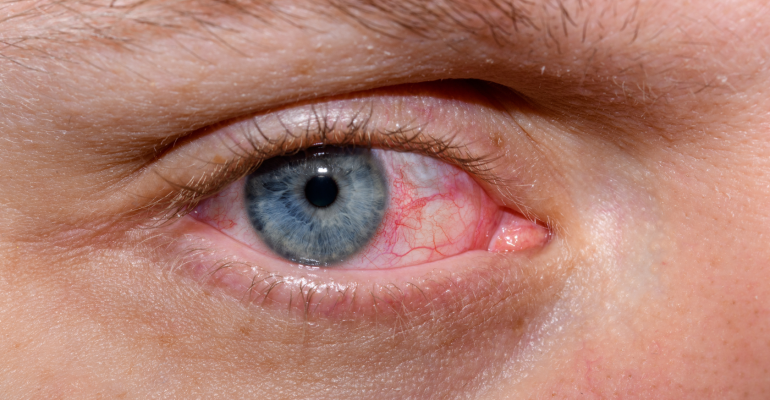Dry eye disease is a common ocular condition that affects millions of people worldwide. It is considered to be heavily under-diagnosed, which means that many people are symptomatic from dry eyes without realising that this is the cause and that there are effective treatments available for it.
Dry eye disease can be caused by several mechanisms, often combining to produce inflammation and instability of the tear film, this leads to symptoms of discomfort, irritation, fatigue and blurred vision.
What is the tear film?
Our eyes are designed to have a liquid layer on the surface to help protect and nourish the front coat of the eye called the cornea.
This tear film is composed of three layers: an inner layer to bind liquid to the surface, a middle aqueous layer and a surface oil layer which helps to evenly spread the tear film and stop it from simply falling off the surface due to gravity.
Tears are produced by the lacrimal gland under the upper outer eyelid and a small amount is replaced with each blink, around 20 times a minute which keeps the surface of the eye clean, healthy and optically ideal.
What causes dry eye disease?
A number of factors can contribute to dry eye disease, both natural, genetic, environmental and linked to other conditions.
Age is an important factor as our production of tears declines with age reducing the quantity as well as a reduction in the quality of the tear film.
As we age, symptoms of dry eye disease as well as signs of dry eyes become more prevalent and are reported in up to 75% of some population studies.
The reduction in the production of tears leads to a form of dry eye called aqueous deficient dry eye disease (ADDE).
Higher rated of dry eye disease are reported in women compared to men, but again, these differences become more pronounced with age.
The reduction of androgens and estrogen with menopause and peri-menopause are thought to play a significant role in higher rates of dry eye disease in women.
Medical conditions such as Sjörgrens syndrome, androgen deficiency and connective tissue diseases are all risk factors for dry eye disease.
Screen use, contact lens wear can also contribute to worsening symptoms. Diabetes, allergic and inflammatory eye conditions are also important risk factors.
A number of medications are linked to dry eye disease by either reducing tear production or irritating the eyes, these include antihistamines, antidepressants and decongestants (a comprehensive list is available at the end of this blog).
Eye drops can also make the symptoms of dry eye disease worse, or can cause irritation to the cornea producing similar effects. In particular, preservatives in eye drops e.g. benzalkalonium chloride (BAK) particularly if drops are applied frequently or a number of preserved drops are used.
Blepharitis (or inflammation of the eyelids) is strongly associated with dry eye disease as inflammation of the eyelids caused by dysfunction of the meibomium glands which open onto the eyelid margin can contribute to destabilising the tear film and increasing evaporation of the aqueous layer or evaporative dry eye (EDE).
What are the symptoms of dry eye disease?
Commonly reported symptoms of dry eye disease are linked to inflammation of the surface of the eye and reduced production of tears. Examples include:
- The feeling of something in the eyes (foreign body sensation) or gritty and uncomfortable eyes.
- Redness and irritation.
- Blurred vision, or vision that seems to come and go with blinking.
- A feeling of eye fatigue.
- Sensitivity to light or a feeling of glare.
- Reflex eye watering, particularly in EDE where tear production may be normal.
The symptoms of dry eye disease are related to the mechanisms of the disease. A lower volume or aqueous in the tear film leads to a more concentrated tear film which irritates the nerves in the cornea causing pain and discomfort. B
lepharitis and loss of the lipid layer leads to increased evaporation and loss of stability of the tear film.
How can dry eyes be treated?
There are a number of ways in which we can manage and treat dry eye disease and its symptoms.
Environmental conditions play a major role in making symptoms worse, so simple measures to modify the environment can be really effective:
- Wear sunglasses in the sun and avoid the wind.
- Avoid air conditioning or move away from air conditioning vents.
- If your environment is centrally heated, particularly the bedroom, consider a humidifier.
- Avoid exposure to smoke. Cigarette smoke contains a number or irritants
There are also things you can do in your daily life to help with dry eye disease, including:
- Staying hydrated and if possible, and drinking a small glass of water before bed.
- Avoiding alcohol or caffeinated drinks in the evening or just before bed.
- Use artificial tears substitutes or topical lubricant drops, ideally those without preservatives. Use them as directed, as frequently as necessary. Artificial tears are particularly useful on waking, as our eyes tend to dry overnight, and in the evenings when EDE tends to be worse.
- Simple lid hygiene measures to treat blepharitis and meibomium gland disease (MGD) can be effective in stabilising the tear film and improving the symptoms of dry eye.
- Warm compresses or the use of microwavable eye masks or compresses help to warm and release oil from the glands inside the eyelids. Lid wipes with bicarbonate of soda or commercially available solutions or pre-soaked wipes to clean in-between the eyelashes of the upper and lower lid reduce lid margin oil blocking the openings of the meibomium glands which in turn reduces inflammation.
Dietary supplements have been shown to be useful in the treatment of dry eye disease, in particular Omega 3 essential fatty acids and linseed or flaxseed.
Medical treatments to treat dry eye disease include:
- Prescription eye drops to reduce inflammatory factors in the tear film.
- Prescription eye drops to reducing immune inflammation in the lacrimal gland which is responsible for producing tears.
- Punctal plugs reduce tear clearance or drainage from the surface of the eye, these can be temporary (which tend to dissolve after a few months) or more permanent (see our animation on tear conservation here: https://bityl.co/MsWx ). Punctal plugs act to conserve tears at the surface of the eye keeping it wetter.
- LipiFlow® Thermal Pulsation treatment. This is a device which warms and massages the eyelid margins reducing blockage of the meibomium glands and improving tear film quality. This treatment is particularly effective in sufferers of a type of blepharitis called meibomium gland disease (MGD) which can affect anyone but can be more prevalent in contact lens wearers, post-menopausal women and heavy screen users who tend to have a lower blink rate.
In summary
Dry eye disease is a common, largely under diagnosed cause of ocular discomfort, fatigue and blurred vision for millions of people world-wide.
Advancing age and female sex are significant risk factors but particularly with the increase in frequency and duration of screen use, dry eye disease can be seen across any age with the incidence increasing.
The tear film is a complex structure and is part of a mechanism called the ocular surface designed to protect the front of the eye, it has different layers and can be deficient in aqueous (aqueous deficiency dry eye or ADDE) or lipid (evaporative dry eye or EDE).
Lifestyle modifications such as avoiding smoke and air conditioning, staying hydrated and eating well are simple but effective environmental measures but there are a wide variety of medical treatments available including the iuse of over the counter, preservative-free topical lubricant eye drops.
These may focus on tear conservation to help ADDE as well as reducing inflammation of the ocular surface to help with EDE or a combination of the two.
Maintaining ocular surface health is essential to maintain comfortable eyes and see well. If you experience persistent problems or symptoms, it is important to consult and eye care professional and seek expert help.
Medical Disclaimer
This article is for information purposes only and should not be considered medical advice. If you or any other person has a medical concern, you should consult with your health care provider or seek other professional medical treatment. Never disregard professional medical advice or delay in seeking it because of something that you have read on this blog, website or in any linked materials.







